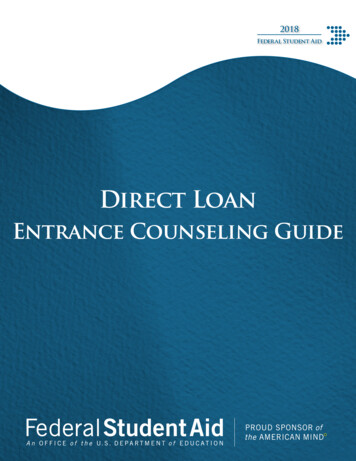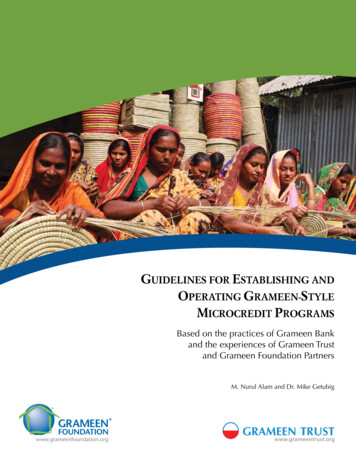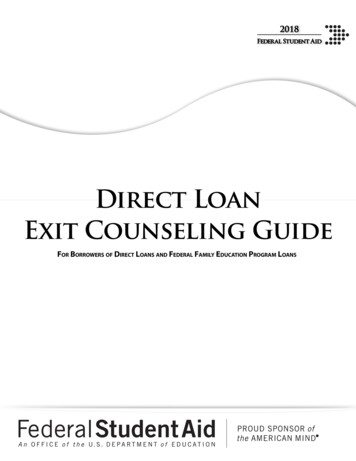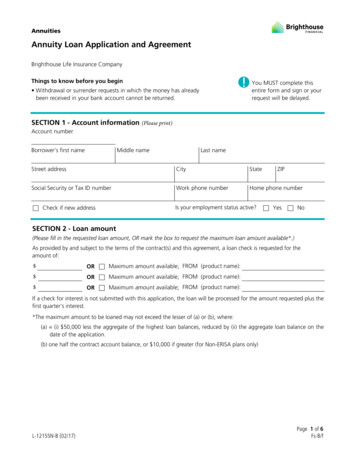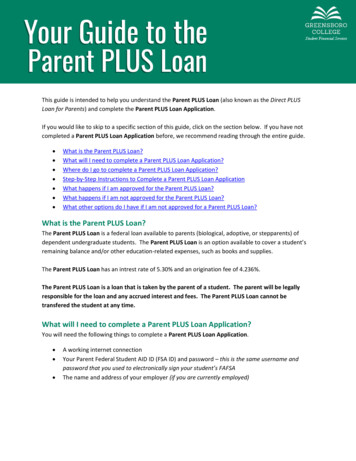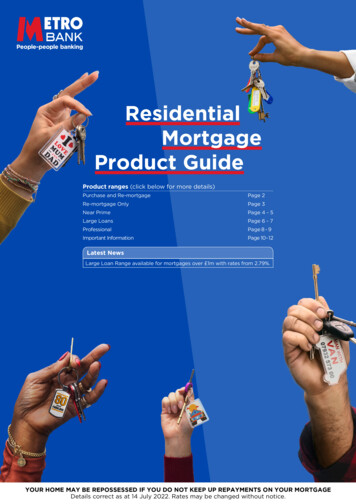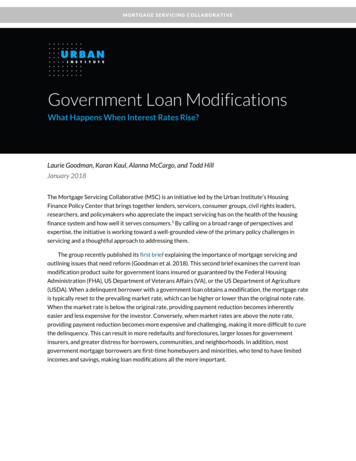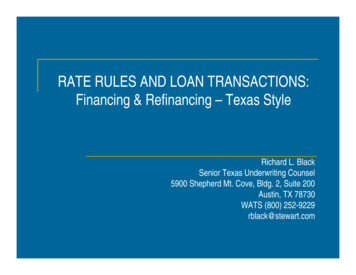
Transcription
RATE RULES AND LOAN TRANSACTIONS:Financing & Refinancing – Texas StyleRichard L. BlackSenior Texas Underwriting Counsel5900 Shepherd Mt. Cove, Bldg. 2, Suite 200Austin, TX 78730WATS (800) 252-9229rblack@stewart.com
1. RATE RULE R-1: Multiple Premium Credits.**If one full premium is charged for the largest Policy in the transaction, there isno limit on the use of premium credits/discounts applicable to other Policies inthe same transaction.EXAMPLE: Seller is selling a commercial property to Purchaser for 500,000. Lender is making Purchaser a 400,000 loan for thepurchase, and Purchaser is simultaneously leasing the property toLessee. Cost to the Seller for an Owner Policy to Purchaser in theamount of the sales price is 3,079. Premium for Lender’s MortgageePolicy is 100 (simultaneous issue under Rule R-5). Cost toPurchaser for a 500,000.00 Leasehold Owner Policy issued toLessee is 923.70 ( 3,079.00 x 30% under Rate Rule R-22).
1. RATE RULE R-1: Multiple Premium Credits.**If a full premium is not charged in the transaction, only one credit/discountcan be applied unless otherwise allowed by a particular Rate Rule. Authorizeddouble credits include the following:a. Credit for a prior qualifying Owner Policy can be given against thecost of a new-construction Owner Policy in combination withsimultaneous-issue of one or more Mortgagee Policies [Rules R-5(A)and R-5(C)].b. A credit for a builder’s Interim Construction Binder can be givenagainst a post-completion purchaser’s Owner Policy in combinationwith simultaneous-issue of a Mortgagee Policy [Rule R-13].
2. RATE RULE R-2: Premium Pass-Through.**General Rule: Premium collected in one transaction cannot be applied to theissuance of a Policy in a different transaction.**Authorized Exception to the General Rule: Two or more conveyances(transfers) of title qualify as “ONE transaction” whenever the followingconditions are met: a) all conveyances involve the identical property; b) allparties to each conveyance agree in writing to the final application of thepremium paid; and c) all deeds making these title transfers are filed on thesame date.
2. RATE RULE R-2: Premium Pass-Through.EXAMPLE: Seller is selling ten acres to Middlebuyer for 20,000.Middlebuyer has contracted to sell the same land to Endbuyer for 30,000. At or before their closing, Seller and Middlebuyer sign aseparate written agreement, by which Seller allows the premium beingpaid by him to be applied to an Owner Policy issued to someone otherthan Middlebuyer. The Middlebuyer/Endbuyer Earnest MoneyContract discloses that a portion of the Owner Policy premium will be paidby Middlebuyer’s seller. The first sale closes on Tuesday morning, and thesecond one closes on Tuesday afternoon. Legitimate pass-through? Yes.Result? Seller pays 308 in Owner Policy premium that is thentransferred to the Middlebuyer/Endbuyer GF File, where Middlebuyer willpay an additional 70 in Owner Policy premium as seller in the secondsale.
3. RATE RULE R-2: “Pay-As-You-Go” Policies.**General Rule: Premium must be paid in full to the issuing title company priorto delivery of the Policy or Endorsement to the Insured.
3. RATE RULE R-2: “Pay-As-You-Go” Policies.**Authorized Exception to the General Rule: A Policy premium can be paid inprogressive installments if a) the face amount of the Policy is 5,000,000 ormore and includes the value of future construction, b) the Policy’s Schedule “B”includes the two contemplated-improvements exceptions from Rule P-8(b)[Mortgagee Policy] or P-8(a) [Owner Policy], PLUS added language for the“Liability” or “Pending disbursement” exceptions required by Rule P-8, and c)Down-Date Endorsements under Rule P-9(b)(4) or P-9(a)(3) are issued at eachstage after the initial closing, at cost of 50 per Endorsement [see Rule R-11(c)for the Mortgagee Policy, and Rule R-15 for the Owner Policy]. “Pay-As-YouGo” can be applied to a Mortgagee Policy alone, an Owner Policy alone, orboth Owner and Mortgagee Policies in the same transaction. When bothPolicies are issued, the Owner Policy is charged for at a simultaneous-issue 100 rate under Rule R-5(B), plus the difference in premium if the Owner Policyamount exceeds the Mortgagee Policy amount.
3. RATE RULE R-2: “Pay-As-You-Go” Policies.EXAMPLE: January closing is a land acquisition in the amount of 600,000 with upcoming construction-cost of 5,400,000. An OwnerPolicy for 6,000,000 ( 27,699 computed premium) and a Mortgage Policyfor 5,700,000 ( 26,577 computed premium) are being required. Atclosing, Lender advances 700,000, being 300,000 toward land-purchaseand 400,000 for initial site work, followed by: 1,500,000 in February, 2,000,000 in April, 1,000,000 in July, and 500,000 in September. “PayAs-Go” premium collection would take place as follows:
3. RATE RULE R-2: “Pay-As-You-Go” Policies.i.January—Mortgagee Policy: Collect 3,263.66 [ 700,000 5,700,000 12.28% x 26,577].January—Owner Policy: Collect 1,222 [ 27,699 - 26,577 1,122 100].ii. February—Mortgagee Policy: Collect 6,995.07 [ 1,500,000 5,700,000 26.32% x 26,577] plus 50 Date-Date Endorsement premium.February—Owner Policy: Collect 50 Down-Date Endorsement premium.iii. April—Mortgagee Policy: Collect 9,325.87 [ 2,000,000 5,700,000 35.09% x 26,577] plus 50 Down-Date Endorsement premium.April—Owner Policy: Collect 50 Down-Date Endorsement Premium.iv. July—Mortgagee Policy: Collect 4,661.61 [ 1,000,000 5,700,000 17.54% x 26,577] plus 50 Down-Date Endorsement premium.July—Owner Policy: Collect 50 Down-Date Endorsement premium.v. September—Mortgagee Policy: Collect 2,330.79 [ 500,000 5,700,000 8.77% x 26,577] plus 50 Down-Date Endorsement premium.September—Owner Policy: Collect 50 Down-Date Endorsement premium.
4. RATE RULE R-4: Valuation of Mortgagee Policy Coverage.**General Rule: The Amount of Insurance in Schedule “A” of the MortgageePolicy should be equal to the principal amount of the promissory note securedby the Insured Mortgage.**First Exception to the General Rule: If the land described in Schedule “A” ofthe Mortgagee Policy is only part of the collateral/security for the loan, theAmount of Insurance in the Policy should be the value of the land or theprincipal amount of secured note, whichever is less.
4. RATE RULE R-4: Valuation of Mortgagee Policy Coverage.**Second Exception to the General Rule: Any lender can request additionalinterest coverage up to 125% of the principal amount of the secured promissorynote, whether or not interest is variable-rate or subject to being capitalized intothe loan principal. If interest coverage causes the amount of a simultaneousissue Mortgagee Policy to exceed the amount of the companion Owner Policy,additional Mortgagee Policy premium must be collected for the excess.EXAMPLE: Sales price and Owner Policy amount will be 100,000.Principal amount of the purchase-money loan will be 95,000. Lenderrequests full 25% interest coverage. Consequently, the amount of statedinsurance in the Schedule “A” of the Mortgagee Policy will be 118,750 (forwhich a full single-issue premium would be 975). Owner Policy premiumis 871. Mortgagee Policy premium will be 204 [ 975 – 871 104 100].
5. RATE RULE R-5(A): Simultaneous-issue Mortgagee Policy.**When an Owner Policy and Mortgagee Policy are issued “simultaneously”,the Owner Policy premium is charged at Basic Rate, and the Mortgagee Policybears a reduced premium of 100. In order for a Mortgagee Policy to be“simultaneous” with an Owner Policy, the following conditions must be met:a) both Policies must reflect the same policy-date; b) the land covered by theMortgagee Policy must be at least part of the land insured by the Owner Policy;and c) Schedule “B” of the Owner Policy must contain an exception to the lieninsured by the Mortgagee Policy. If the amount of the Mortgagee Policyexceeds the amount of the Owner Policy, premium for the excess must becharged in addition to the simultaneous-issue rate [(Basic Rate premiumcalculated on loan amount) – (Owner Policy premium) 100].
5. RATE RULE R-5(A): Simultaneous-Issue Mortgagee Policy.EXAMPLE: As part of the sales price, Buyers are assuming the balance ofSeller’s existing mortgage note put in place eight years ago. Seller isproviding an Owner Policy to Buyers. As a condition for accepting Buyersas obligors under a Modification Agreement, Seller’s Lender has requiredthat the assumed loan be cross-collateralized with another real estate liennote made by Buyers and held by Seller’s Lender. Seller’s Lender hasalso required a Modification Endorsement to its existing Mortgagee Policy.Problem? Fresh cross-collateralization in a Modification Agreementdisqualifies the transaction from a Rule P-9(b)(3) ModificationEndorsement. What else is available? A new Mortgagee Policy! It can beissued on the original 1998 Deed of Trust as modified by the ModificationAgreement, dated as of the filing of the Modification Agreement, with theinsurance-amount being equal to the current principal balance of theassumed note. AND, in conjunction with the Owner Policy being issued toBuyers, this new Mortgagee Policy can be issued at the simultaneousissue rate of 100 ( 70 cheaper than a Modification Endorsement).
6. RATE RULE R-6(A): Subsequent-Issue Mortgagee Policy (withPrior Qualifying Owner Policy).**When a prior sale-transaction created a purchase-money Deed of Trust, butonly an Owner Policy was issued at the time, a Mortgagee Policy insuring thelien can be issued at a later date. The present lienholder can be required toprovide a written statement affirming the current principal balance of thesecured note and the fact that the note is not in default. Amount of Insuranceunder the Policy must equal the outstanding principal balance. The Policy maybe dated as of the filing-date of the Deed of Trust or any later date throughwhich examination of title is current (see Basic Manual Appendix Bulletin No.152). Regardless of the Insured Mortgage’s age, a 50% premium-creditapplies if the following conditions are met: a) The prior Owner Policy containsa Schedule “B” exception to the purchase-money lien now being insured; b) theDeed of Trust has not been renewed, extended, or modified; and 3) the NamedInsured of the Mortgagee Policy is the original beneficiary of the Deed of Trust.When this credit/discount is applied, the resulting premium can be less thanMinimum Basic Rate.
6. RATE RULE R-6(A): Subsequent-Issue Mortgagee Policy (withPrior Qualifying Owner Policy).EXAMPLE: As seller at the time, Noteholder received a promissorynote and Deed of Trust when he sold a one-four-family residentialproperty in 1996. However, Noteholder did not require a MortgageePolicy covering his seller-carried lien. Noteholder is now selling thenote to Assignee. Current principal balance of the note is 31,661. TheDeed of Trust has never been modified. Assignee insists on receiving aMortgagee Policy, but has agreed to accept a Policy issued to Noteholderas the Named Insured, not to Assignee. A full single-issue premium undertoday’s Premium Schedule would be 388. Consequently, cost of aMortgagee Policy issued today, in the amount of 31,661 and insuring the1996 Deed of Trust, will be 194 [ 388 – ( 388 x 50%)].
7. RATE RULE R-6(B): Subsequent-Issue Mortgagee Policy (withPrior Qualifying Mortgagee Policy).**When a Deed of Trust is presently covered by a Mortgagee Policy, a newPolicy can be issued to insure the same lien. The Amount of Insurance in thenew Policy must be equal to the current principal balance of the promissorynote secured by the lien. Regardless of the Insured Mortgage’s age, a 30%premium-credit applies, so long as the Deed of Trust has never been renewedand extended by a later Deed of Trust (intervening modification agreements,including an extension of maturity, do not negate this credit). The Policy can beissued to an assignee of the original lienholder, in which case the Date ofPolicy will be the date on which the Assignment of Lien was filed. When thiscredit/discount is applied, the resulting premium can be less than MinimumBasic Rate.
7. RATE RULE R-6(B): Subsequent-Issue Mortgagee Policy (withPrior Qualifying Mortgagee Policy).EXAMPLE: When he sold his home in 2000, Noteholder received apromissory note and Deed of Trust, and he required his purchaser topay for a Mortgagee Policy covering the lien. Noteholder is now selling thenote to Assignee. Current principal balance of the note is 77,555.Assignee insists on receiving a Mortgagee Policy issued in its name as theNamed Insured. A full single-issue premium under the today’s premiumschedule would be 717. Consequently, cost of a new Mortgagee Policyin the amount of 77,555 and insuring the 2000 Deed of Trust will be 501.90 [ 717 – ( 717 x 30%)].
8. RATE RULE R-7: First and Subordinate-Lien MortgageePolicies.**When one transaction on the same property involves two or more loans ofdescending priority, each of which is to be covered by a separate MortgageePolicy, premiums are charged as follows: a) cost of the first-lien Policy is asingle-issue premium calculated on the combined total of all of the liens beinginsured, and b) cost of each subordinate-lien Policy is 5. This Rule is appliedwhen no Owner Policy is involved (since, otherwise, the Mortgagee Policieswould be charged as simultaneous issues under Rule R-5) and when no othermore advantageous credits are available.
8. RATE RULE R-7: First and Subordinate-Lien MortgageePolicies.EXAMPLE: On his commercial property, Borrower is refinancing a2003 Deed of Trust and also obtaining a separate business line-of-credit.Lender is requiring that Borrower also include his adjacent debt-freeproperty as additional collateral. Lender is structuring the new loans in thefollowing manner: a first-lien Deed of Trust securing a long-term 600,000note; a second-lien Deed of Trust on a shorter-term 200,000 note; and athird-lien Deed of Trust securing a 100,000 revolving-credit note.Premiums for the three Policies will be charged as follows: First-lienMortgagee Policy ( 600,000 face-amount) will cost 5,287 [calculatedpremium on 900,000 ( 600,000 200,000 100,000)]; and the cost forthe second-lien and third-lien Policies will be 5 each.
9. RATE RULE R-8: Refinance Credits.**Under certain circumstances, one or more mandatory premium-credits mayapply a Mortgagee Policy or Policies are being issued in connection with arefinance loan transaction. The following conditions must be met in order forthe Policy or Policies to qualify the credit(s): a) The entire outstanding balanceof the existing lien must be paid off in the refinance transaction; and b) eachlien being refinanced must be covered by a Mortgagee Policy (but, in absenceof actual knowledge that an existing lien is uninsured, the issuing title companymust assume that the lien was insured, and it is NOT necessary for eachexisting lien to generate an actual credit).
9. RATE RULE R-8: Refinance Credits.**Calculation and Application of Refinance Credits:i) Each individual credit is calculated on the basis of the outstanding totalof principal and interest owing under the existing note being refinancedOR its original principal balance, whichever is less. The credit is NOTaffected by any principal-reduction paid by the borrower at closing ofthe refinance loan transaction.ii) Multiple credits for one new Policy are added together and thensubtracted from a full single-issue premium calculated on the newrefinance loan amount.iii) Credits are stair-stepped according to the age of the lien beingrefinanced (40% within the first two years, 35% within the 3rd year, etc.,declining 5% per year down to 15% within the 7th year, with no creditavailable after seven years.) Age of the existing lien is alwaysdetermined in reference to the filing-date of the current Deed of Trust,without regard to the fact that it, too, may have been a refinancetransaction.
9. RATE RULE R-8: Refinance Credits.**Calculation and Application of Refinance Credits continued:iv) When a single existing lien-balance is refinanced into two new Deedsof Trust (first and second liens), the credit generated by the existing lienis applied to the premium for the new first-lien Mortgagee Policy. Thiscredit is not affected if no Policy is required for the new second lien.v) When existing first and second liens are refinanced by new first andsecond liens, the first-lien credit is applied to cost of the new first-lienMortgagee Policy, and the second-lien credit is applied to the cost ofthe new second-lien Policy.
9. RATE RULE R-8: Refinance Credits.EXAMPLE: Borrowers are refinancing their 18-month-old home mortgage,quoted payoff for which is 186,276. As shown by the existing Deed ofTrust, the original principal amount of the debt was 185,000. Theapplicable refinance premium credit will be 536, which is a 40% creditcalculated on 185,000 (NOT on the 186,276 loan-payoff amount).
9. RATE RULE R-8: Refinance Credits.EXAMPLE: Refinancing Borrower is consolidating three liens on threetracts: Tract No. 1, balance of 87,051 on a 1996 loan; Tract No. 2,balance of 97,811 on a 100,000 Deed of trust filed 7/1/02; and, finally,Tract No. 3, balance of 46,032 on a 50,000 Deed of Trust filed 1/10/01.In a 1/19/06 refinance closing, the following Rule R-8 credits areapplicable: From Tract No. 1, zero; from Tract No. 2, 257.10 [ 857 x30%]; and from Tract No. 3, 98.20 [ 491 x 20%]. Total premium credit tobe applied is 355.30.
Send an e-mail to Maurine Reid at:mareid@stewart.comWith the following information:¾Today’s password¾Your Name (the way you want it onthe certificate)¾Your email address so we can emailyour certificate
RATE RULES AND LOAN TRANSACTIONS: Financing & Refinancing - Texas Style Richard L. Black Senior Texas Underwriting Counsel 5900 Shepherd Mt. Cove, Bldg. 2, Suite 200 Austin, TX 78730 WATS (800) 252-9229 rblack@stewart.com. 1. RATE RULE R-1: Multiple Premium Credits. . Financing & Refinancing - Texas Style .
